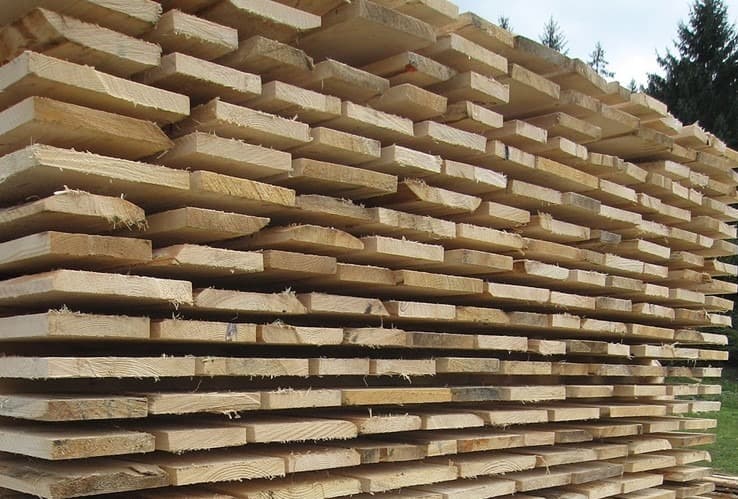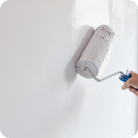Construction Material Storage: 7 Tips for Storing the Right Way
.jpg?sfvrsn=e18c0c6e_0)
Have you ever gotten to the end of a home improvement project and wished for a construction material storage solution? It’s a valid consideration since building materials aren’t cheap, so why not save your excess materials for a future renovation project.
Different construction materials require different storage methods in order to be reusable. If not properly stored, these construction materials will degrade making them useless for your next DIY project.
To ensure that this does not happen to you, here are some storage tips for the most common construction materials used in home improvement projects.
- Lumber
- Bricks
- Tile
- Roof Shingles
- Cement
- Paint and Primer
- Glue
Lumber
How to store lumber is one of the most common construction material storage questions we get.
Lumber easily absorbs moisture because of its porous nature.
When some parts of a wooden beam absorb more moisture than other parts of it, it causes the beam to become misshapen (warp). This in turn causes lumber to be difficult to work with or even unusable in many cases.
Therefore, it is necessary to keep lumber in a dry environment when storing it.
There are a couple of ways of storing lumber in a way that stops it from warping:

1. Horizontal Storage
Make sure to keep your lumber off the ground when storing them horizontally to allow ventilation around it.
You can do this by creating a base made of cinder blocks placed a few feet away from each other and spanned with seasoned wood in between them.
It is recommended to keep each set of cinder blocks and seasoned wood one to two feet apart to create a support that can help minimize the warping of the lumber.
Depending on the type of lumber, you may need to decrease the gaps between the sets of cinder blocks and seasoned wood to ensure that the unsupported parts of the wooden beams do not warp.
Redwood, for example, is less likely to warp because of its natural chemical called tannins that protects it from excess moisture. Therefore, the two-foot gap would be acceptable for this type of wood.
Elmwood, though, warps easily. Therefore, it needs to have a base with closer gaps to reduce warping.
You should also place thin strips of wood called stickers between each layer of lumber to encourage air movement. As an alternative, you can use plastic stickers made of PVC pipes for better airflow.
You also need to cover your pile with a waterproof tarp to protect your wood from the elements.
Don't forget to set some bricks on top of the tarp to put even pressure on the wood.
Leveling the pressure will help spread the moisture that could get into the lumber across its whole body, keeping a specific area from warping.
2. Vertical Storage
Vertical storage is suitable for those who want to keep their lumber indoors but are short on space.
You should still keep the lumber raised to avoid water seeping from the ground, but you also need to make sure that the top and bottom parts of the beam are supported to prevent bowing.
One great way to ensure this is by purchasing or creating your own vertical storage rack.
We recommend spending some extra money and buying cured wood instead if you're planning on keeping lumber for an extended period of time.
It is more expensive, but it will save you money in the long run as it lasts longer compared to standard wood when stored properly.
Bricks
Storing bricks is relatively easy because they are more durable compared to lumber.
You should keep them away from long and continued exposure to water and prevent any accident that could cause them to crack or break.
If you'll be storing them outside, keep the bottom layer off the ground or lay a waterproof tarp to prevent contact with rainwater. You can also cover them for added protection.
You can eliminate having your bricks exposed to water by storing them in a storage unit.
Tiles
Tiles are non-porous, so water damage is less likely to happen. However, it is still best to keep your tiles in a cool, dry place as excess heat can make cracking more likely.
Stack your tiles upright instead of flat so that there is no chance that they will topple over and break.
Likewise, you should stack only up to four layers of tiles to reduce the pressure on the bottom tiles.
Roof Shingles
Even though asphalt roof shingles are designed to endure the effects of different weather and climates, the Asphalt Roofing Manufacturers Association (ARMA) still recommends keeping them in a cool, dry place when storing them for an extended period.
Asphalt roof shingles can deform when stacked too high and exposed to temperatures exceeding 110 degrees Fahrenheit. They also become less flexible and tend to crack in temperatures below 40 degrees Fahrenheit.
It is best to store your asphalt roof shingles in a climate-controlled storage unit to make them last the maximum amount of time possible when in storage.

Cement
It is very important to keep cement dry, as any contact with moisture can cause it to set. Therefore, storing cement outside is not advisable even when covered with a waterproof tarp.
You should keep it in a dry and contained area with enough ventilation to keep the circulation of air.
You also need to keep the cement bags at least two feet away from the nearest wall and ceiling and raised from the ground. This is because walls, ceiling, and floor can still suffer from dampness.
Cover your stacks as well with waterproof tarps in case of water leakage from the roof.
Paint and Primer
You can make your leftover paint and primer last longer by keeping heat and air away from them.
You want to store your paint and primer in a location where it's cool but not too cold for them to freeze. The optimal temperature is between 50 to 75 degrees Fahrenheit.
You should keep paints and primers in smaller canisters if possible, as a smaller container means less room for air.
However, if you want to keep them in their original container, refrain from hammering down the lid as it can cause an indentation on the lid or the rim where air can enter.
It is also recommended to place a layer of plastic wrap on top of the rim before closing the lid. This will block additional air from entering and will also prevent rust from falling to the paint in case the lid becomes rusty from humidity.
Glue
Glues dry out when exposed to heat and air for a long time. It should be then your top priority to close the lid open after every use.
Glue also runs the risk of freezing in cold conditions.
Most glues can only withstand a maximum of five freezing and thawing cycles. After each cycle, the glue forms into gels that are difficult to break up.
It is recommended to keep small bottles of glue in the refrigerator as they can stay cool without freezing.
How do you store Construction Materials?
- Train Your Staff
Construction materials can be hazardous. They may contain dangerous chemicals or they may be heavy and therefore hazardous when stacked. The important thing is that your staff understands the associated risks and knows how to store them properly. Be sure that your new employees are getting the proper training as well.
- Consider the Elements
Sun, wind, and moisture can take a serious toll on your materials. It's important to protect them from the elements to ensure that you don't end up wasting money because of damaged materials. Consider what you're storing and what they'll need to avoid being ruined.
- Know Your Weight Limits
The last thing you want is to over-stack your materials. This creates a serious fall risk that can result in injury and even death. Most materials will list their storage weight limit on their outer cover. Take this into consideration and take it seriously.
- Don't Mix Your Materials
Certain materials and chemicals can react with each other, especially when packed in close quarters together. This can result in damage and/or hazardous situations, including fire. So keep your materials separated by type to avoid this.
- Keep Security in Mind
Another concern for construction materials is theft, especially these days when lumber is valuable and in short supply. If you leave your supplies somewhere visible and easily accessed, you run the risk of someone taking a five-finger discount on your items.
The Takeaway for Construction Material Storage
Proper construction material storage of home improvement items is imperative in keeping them in excellent condition and for them to last longer.
It can be a challenge though to achieve the best conditions for them to have an extended shelf life, especially with the changing weather and temperature.
In this case, climate-controlled storage units are one of the best available options for both residential and commercial renters. Check out our post on climate-controlled storage units to learn more.
This article is contributed by Volodymyr Barabakh of Fortress Home.






